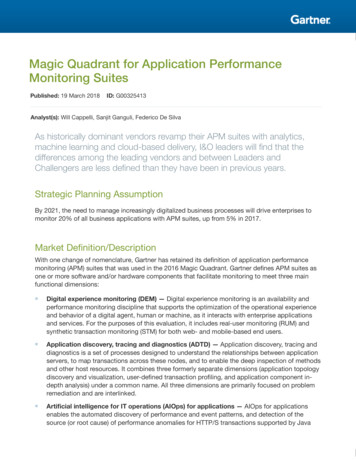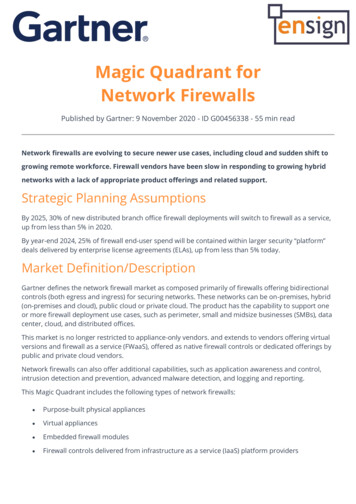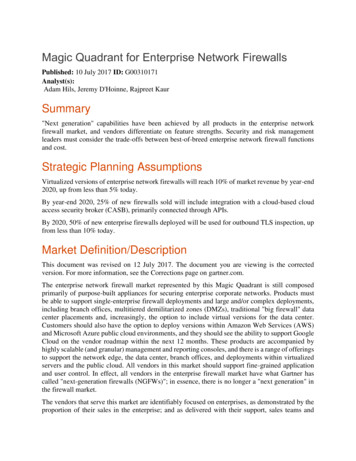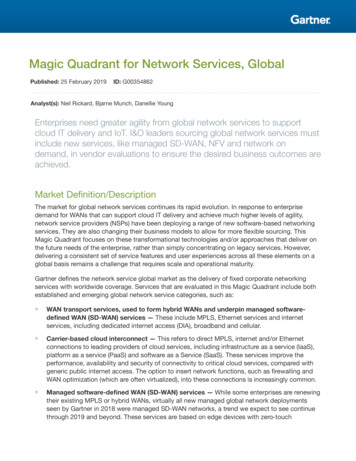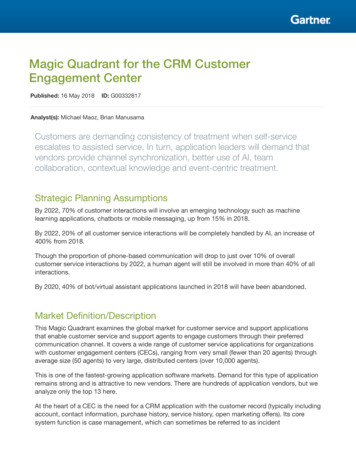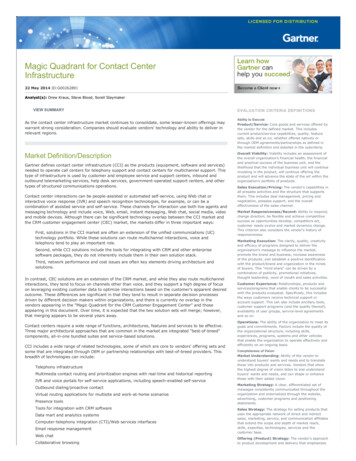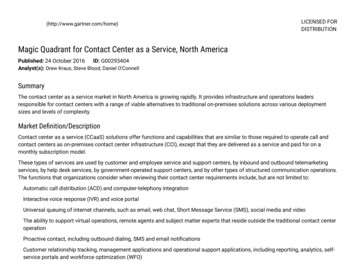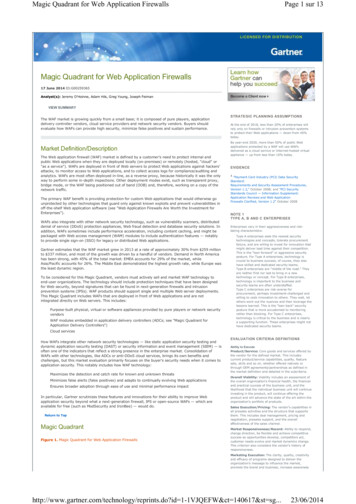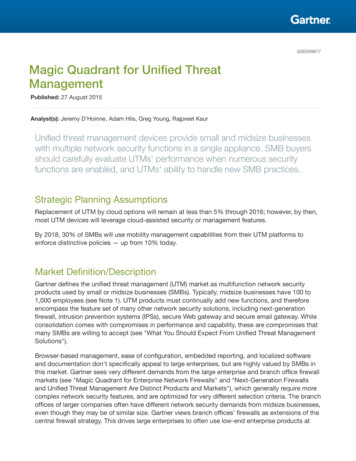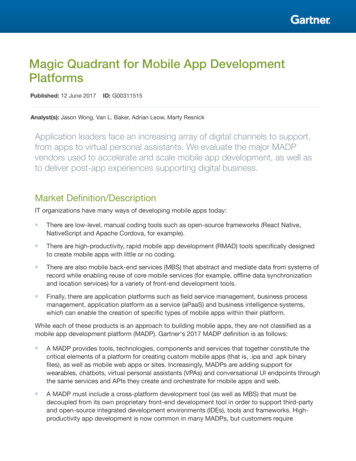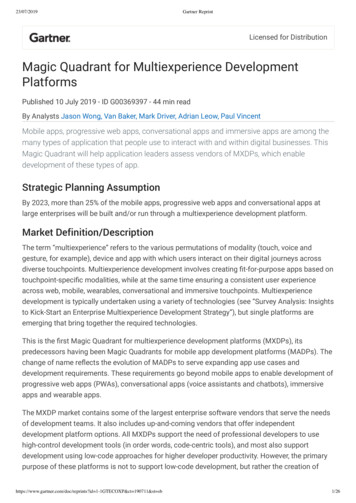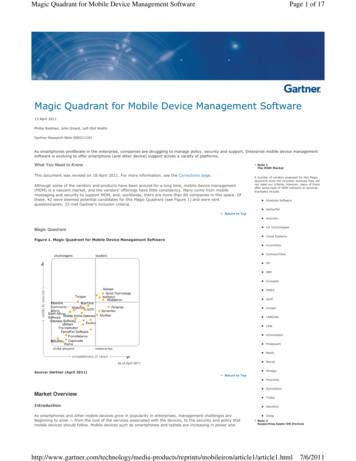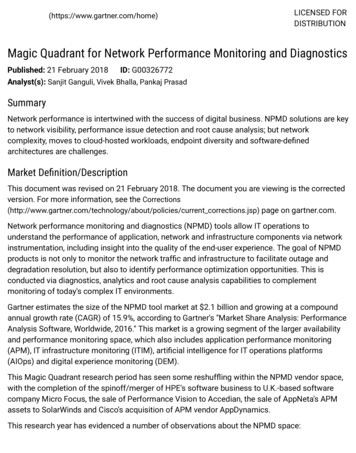
Transcription
(https://www.gartner.com/home)LICENSED FORDISTRIBUTIONMagic Quadrant for Network Performance Monitoring and DiagnosticsPublished: 21 February 2018 ID: G00326772Analyst(s): Sanjit Ganguli, Vivek Bhalla, Pankaj PrasadSummaryNetwork performance is intertwined with the success of digital business. NPMD solutions are keyto network visibility, performance issue detection and root cause analysis; but networkcomplexity, moves to cloud-hosted workloads, endpoint diversity and software-definedarchitectures are challenges.Market Definition/DescriptionThis document was revised on 21 February 2018. The document you are viewing is the correctedversion. For more information, see the t/policies/current corrections.jsp) page on gartner.com.Network performance monitoring and diagnostics (NPMD) tools allow IT operations tounderstand the performance of application, network and infrastructure components via networkinstrumentation, including insight into the quality of the end-user experience. The goal of NPMDproducts is not only to monitor the network traffic and infrastructure to facilitate outage anddegradation resolution, but also to identify performance optimization opportunities. This isconducted via diagnostics, analytics and root cause analysis capabilities to complementmonitoring of today's complex IT environments.Gartner estimates the size of the NPMD tool market at 2.1 billion and growing at a compoundannual growth rate (CAGR) of 15.9%, according to Gartner's "Market Share Analysis: PerformanceAnalysis Software, Worldwide, 2016." This market is a growing segment of the larger availabilityand performance monitoring space, which also includes application performance monitoring(APM), IT infrastructure monitoring (ITIM), artificial intelligence for IT operations platforms(AIOps) and digital experience monitoring (DEM).This Magic Quadrant research period has seen some reshuffling within the NPMD vendor space,with the completion of the spinoff/merger of HPE's software business to U.K.-based softwarecompany Micro Focus, the sale of Performance Vision to Accedian, the sale of AppNeta's APMassets to SolarWinds and Cisco's acquisition of APM vendor AppDynamics.This research year has evidenced a number of observations about the NPMD space:
Cutting-edge innovation in this mature industry (with vendors having an average life span of 17years) is muted compared to other monitoring areas, with many vendors focusing on GUIupdates, integrations and product rationalization.The NPMD vendor market has split into two camps: those focused on polling-basedinfrastructure monitoring with basic flow and packet monitoring capabilities, and those focusedon hardware-based deep packet analysis with basic infrastructure monitoring. While we hadexpected to see vendors moving toward bringing these two camps together into a single,holistic product offering, we have instead seen an NPMD vendor landscape that hascrystallized. This has created distinct patterns among end users:Those that tend to invest broadly in packet and infrastructure monitoring solutions, oftenacross different vendors, but still have issues with the consumability of their packetmonitoring solution. This is exacerbated by increasing data center data rates, virtualization,cloud migration and encryption.Those that invest more narrowly in infrastructure-focused monitoring, and that reportfrustration in their inability to do root cause analysis without deeper monitoring. Some look toAIOps solutions as a possible remedy.Finally, a number of vendors have initiated a concerted effort to target the cybersecuritymarket, given the growing interest in network traffic analytics from security operations teams.Magic QuadrantFigure 1. Magic Quadrant for Network Performance Monitoring and Diagnostics
Source: Gartner (February 2018)Vendor Strengths and CautionsAccedian (Performance Vision)Based in Paris, France, Performance Vision (PV) is a new entrant in this year's Magic Quadrantwith its NPMD offering. The PV solution can be deployed as a hardware or software appliance.PV is a packet-oriented solution, with software-defined networking (SDN) and network functionvirtualization (NFV) capabilities, including monitoring of database transactions and unifiedcommunications (UC). It classifies applications through analysis of the packet data and captures
end-user experience by computing the total response time for particular applications. The recentproduct release in April 2017 included a new Micro Capture Appliance that is targeted at smallremote sites.The vendor predominantly sells to customers in EMEA and has a very low penetration in all otherregions. Most of PV's customers are midsize enterprises. PV primarily sells through channelpartners, which include network integrators, NPMD specialists and service providers. Toward thisgoal, PV runs a regular partner certification training program.Performance Vision was acquired by Accedian in December 2017. The change of ownership isnot reflected in this research.Performance Vision's NPMD revenue is estimated to be between 5 million and 10 million peryear.STRENGTHSPerformance Vision's NPMD solution offers reduced deployment and maintenance complexitydue to its simple deployment model.Performance Vision has established a strong technical partnership with VMware, with amajority of customers using PV's virtual appliance within their VMware environment.The vendor's focus on monitoring SDN, cloud and virtual environments is a differentiator withinthe NPMD market.CAUTIONSThe UI is heavily focused on diagnostic capabilities and can present visualization challengesfor nontroubleshooting use cases.Performance Vision has a heavy presence in EMEA, which may present challenges from asupport perspective when increasing its penetration in other markets.Although the deployment model is quite simple, the licensing and pricing model can be quitecomplex for PV's customers.AppNetaFounded in 2011, Boston-based AppNeta offers a SaaS-based solution focused on monitoring theend-to-end network performance of the remote office/branch office. This narrowed focus was aresult of the divestiture of its APM capability (TraceView) in a sale to SolarWinds in August 2016.Accompanying this shift, AppNeta has repackaged its monitoring capabilities into a singlepackage called the AppNeta Performance Manager. This combines the capabilities of threepreviously separate modules (PathView, AppView and FlowView) to provide active network pathmonitoring of application delivery, application usage analysis and synthetic web transactions for
application experience. The solution requires the installation of a physical or virtual appliance atthe end location to perform the synthetic tests and path analysis, from which the SaaS-basedanalysis occurs, leveraging deep packet inspection and AppNeta's TruPath technology.AppNeta's plans include enhancing its solutions with technical integrations, particularly for cloudcentric monitoring, while also enhancing its analytics. AppNeta has also hired a new chiefcustomer officer and a SVP of sales over the past year, articulated as part of its plans to improveits global presence and to expand the limited channel partner program. AppNeta currently has aresell relationship with NPMD vendor SevOne, which incorporates several AppNeta capabilitiesinto its solution.AppNeta's NPMD revenue is estimated to be between 25 million and 50 million per year.STRENGTHSA SaaS-focused model allows a high frequency of product enhancement, with PerformanceManager receiving updates every two weeks.Repackaging efforts and a refocus of the company has contributed to a healthy customergrowth rate.AppNeta uniquely addresses a need to manage cloud and UC performance at remote locationsthat communicate directly to the cloud, as traditional data-center-based monitoring approachesfail to see this traffic.CAUTIONSThe focus on the remote office/branch office limits AppNeta's ability to meet end-userrequirements for a holistic network performance monitoring platform for private data centernetworks.Third-party integration with other IT operations tools are lacking, specifically for IT servicemanagement platforms, limiting the ability to integrate AppNeta into end-to-end workflows.Security and privacy perception issues related to SaaS products persist among risk-averse endusers. This is a sales inhibitor when competing against traditional on-premises-based tools.CA TechnologiesHeadquartered in New York City, CA Technologies has a 24-year history in network performancemonitoring, with a software suite built over many years of acquisitions and organic development.Given this history, CA has recently consolidated its APM, ITIM and NPMD business units under asingle product management leader.CA Technologies' NPMD offering has shifted from previous incarnations, and is now branded asthe Network Operations and Analytics (NetOps) platform. This platform comprises existing CAproducts, including CA Performance Management for infrastructure monitoring, CA Network FlowAnalysis for flow monitoring, CA Application Delivery Analysis for packet monitoring, CASpectrum for fault and event management, CA Unified Communications Monitor for voice and
video monitoring, and CA Virtual Network Assurance for SDN/NFV monitoring. Accompanying itsNetOps platform is the recently released CA Digital Experience Insights, which is a SaaS-basedanalytics offering that aims to integrate customer experience, application performance,infrastructure and network management services for a holistic view into performance.The NetOps platform leverages CA Performance Management as the central point of the newNPMD architecture, which is a departure from CA's previous strategy of leveraging CA UnifiedInfrastructure Management as its consolidation platform. CA continues to focus its R&D onmonitoring modern networking infrastructure, including the cloud, SDN, software-defined WAN(SD-WAN), virtual customer premises equipment (vCPE), Internet of Things (IoT) devices andsecurity devices.CA's NPMD revenue is estimated to be between 100 million and 250 million per year.STRENGTHSPositive financial viability continues to show that there is limited risk to stability in doingbusiness with CA Technologies.Recent announcements of CA Digital Experience Insights along with a merging of businessunits represent a much-needed consolidation strategy for CA's disjointed product sets.Execution against this strategy will be critical.CA is improving its interoperability with APIs, allowing the ingestion of third-party data and theability to incorporate third-party analytical engines outside of the CA suite of products.CAUTIONSCA's focus on infrastructure monitoring limits its ability to compete with leading NPMD vendorsthat provide modern packet and flow monitoring technologies.End-user survey results show that CA's cost of implementation, training and professionalservices is among the highest of NPMD vendors, as a percentage of total solution costs.Gartner inquiries have shown that unclear development and migration strategies for CASpectrum and CA eHealth customers have caused confusion among end users.CiscoSan Jose, California-based Cisco has offered network performance monitoring solutions for 19years as part of its network-hardware-centric heritage, and it enjoys broad name recognition. Thevendor has undergone internal consolidation of its enterprise networking business units tocombine various automation and monitoring products into one organization under the DigitalNetwork Architecture (DNA) platform.Cisco's NPMD capabilities remain distributed across various product lines. Its most widelydistributed NPMD offering remains Prime Infrastructure, and it is used for Simple NetworkManagement Protocol (SNMP), Syslog and flow monitoring, configuration management, andprovisioning of Cisco network devices. This is supplemented with Prime Network Analysis
Module for packet analysis, and Prime Collaboration Assurance for UC monitoring. Cisco NexusData Broker provides network packet broker (NPB) functionality. Cisco also offers ApplicationPolicy Infrastructure Controller Enterprise Module (APIC-EM), its policy-based SDN controller,which provides path analytics along with quality of service (QoS) automation capabilities. CiscoStealthwatch and Cisco Tetration round out the portfolio with security-focused capabilities.New to the mix is the first incarnation of Cisco's DNA Center, which aims to bring intent-basednetworking, analytics and programmability to network management. Initially, DNA Center willsupport Software-Defined Access (SD-Access) and wireless assurance with plans to address bigdata analytics and intent-based networking use cases. Cisco also entered into the applicationperformance monitoring market with its purchase of a leading APM vendor, AppDynamics, inMarch 2017. The prospect of integrating AppDynamics with Cisco's NPMD solution is intriguing,but definitive plans have yet to be announced.Cisco's NPMD revenue is estimated to be between 51 million and 100 million per year.STRENGTHSA consolidated organization focused on holistic network management is a welcome start torationalizing and coordinating Cisco's disjointed NPMD offerings.DNA Center's promise of providing a single assurance and automation architecture for LAN,WAN, campus and cloud, by leveraging a broad set of data sources, is potentially disruptive.Execution against this promise will be critical.Positive financial viability continues to show that there is limited risk to stability in doingbusiness with Cisco.CAUTIONSWhile initially promising, Gartner has observed limited market penetration of Cisco Tetrationamong NPMD buyers, due in part to its focus on security workflows.Despite Cisco expanding its customer base for its NPMD solution with new license bundles,Gartner has observed a general lack of awareness of its capabilities.The large majority of Cisco's NPMD sales are tied to Cisco hardware purchases. The vendormisses the ability to cater to general NPMD use cases in an increasingly heterogeneousnetworking environment.ColasoftColasoft is a privately owned company founded in 2001, headquartered in Chengdu, China, and isa new entrant in this year's Magic Quadrant. Colasoft focuses on visually based and metricoriented packet analysis to help simplify network management.Colasoft's NPMD solution consists of three components: Unified Performance Management(UPM), nChronos and Capsa. UPM is the visualization layer that delivers business- and serviceoriented performance views, full network path analysis, and proactive performance issue
detection, all based upon data collected by nChronos. nChronos provides packet capture withhistorical and real-time analysis of application-oriented performance metrics for every TCPconversation. Capsa is a network analyzer that provides packet sniffing and capture whereapplication decoding and deep domain analysis is required. A limited version of Capsa, CapsaFree, is also available to download.A steady stream of product updates was made throughout 2016 and 2017. Following on fromseven product releases in 2016, new releases delivered application analysis for approximately1,800 predetermined applications. Custom applications could also be defined based on InternetProtocol (IP) address, port number, protocol, packet pattern, or a combination of any or allcriteria. The latest release of Capsa added support for Session Initiation Protocol (SIP) and theH.323 protocol, alongside reporting and diagnostics on voice over IP (VoIP) statistics. The latestrelease of nChronos added NetFlow and agent analysis, as well as the ability to collect networktraffic from virtual environments and cloud platforms.Aside from product development, in June 2017 Colasoft joined the Cisco Solution PartnerProgram as a Solution Partner. Colasoft has developed significant presence in governmentorganizations, while other vertical industries have yet to be targeted to the same level. Outside ofChina, the primary route to market for Colasoft is through channel sales, particularly for regionsbeyond Asia/Pacific (APAC). However, the number of partners are few, and this is an area offocus for the company.Colasoft's NPMD revenue is estimated to be between 11 million and 25 million per year.STRENGTHSColasoft experienced rapid year-over-year growth of 94% in 2015 and 62% in 2016, with asignificant installed base of over 10,000 paying customers and 500,000 freeware users.The vendor's products provide strong troubleshooting capabilities, with all metrics collectedand reported at a one-second granularity rate.Colasoft has shown a strong focus on R&D, with over 100 engineers dedicated to developingColasoft's NPMD solution.CAUTIONSIn-house resources are almost exclusively based in the Asia/Pacific region. Customers fromother regions should ensure the reseller resources made available are adequate and sufficientlyskilled to provide ongoing support.Colasoft's channel program is less geographically diverse when compared to leading NPMDvendors, limiting its sales reach globally.Colasoft's ability to monitor infrastructure metrics is limited.Corvil
Founded in 2000, Dublin, Ireland-based Corvil focuses on short-time scale network monitoring,providing comprehensive multisegment and highly accurate packet analysis. These capabilitieshave always appealed to the vendor's financial services customer base's heritage; however, Corvilcontinues its transition — based on its streaming analytics platform — to deliver machine-timedata visibility and operational intelligence to a broader target audience.Product development has progressed with a significant product update released in May 2017.This included a software sensor to instrument network packet data in private cloud, public cloudand private virtualized environments. It should be noted that this is not a virtual appliance nor asynthetic monitoring component. New productized integrations for LiveAction, Cisco Tetrationand an additional Splunk app have also been included in the new version.Aside from product development, Gartner has observed increased collaboration between Corviland its technology partners in terms of increased presence at key partner events, joining Splunk'sAdaptive Responsive Initiative, and holding joint events with Cisco and LiveAction.Corvil's NPMD revenue is estimated to be between 26 million and 50 million per year.STRENGTHSCorvil has experienced healthy sales performance and growth, with total revenue growing by36% year over year.The machine-time data analytics concept aligns well to end users with IoT initiatives.Targeted productized integrations with Splunk, LiveAction and Cisco enhance the overall Corvilvalue proposition.CAUTIONSCorvil's software sensor provides packet-only visibility for those customers that are migratingcritical services into virtual and cloud environments, lacking support for other data sources orsynthetic monitoring approaches.SNMP and flow-based data source support remain comparatively weak.Over the last 12 months, end users have cited increased issues concerning the cost ofimplementation and maintenance.ExtraHopExtraHop, headquartered in Seattle, Washington, and founded in 2007, focuses on packetanalytics for performance and application insights. Over the past year, ExtraHop has released aSaaS-based anomaly detection offering to accompany its hardware and virtual appliances.The vendor's solution is called the ExtraHop platform, which is sold as a single solutioncustomizable with different appliance configurations, modules and bundles. The ExtraHop stackincludes the ExtraHop Discover Appliance, which provides real-time analysis on network data; theExtraHop Explore Appliance, which provides indexing and storage of transaction records; the
ExtraHop Trace Appliance, which provides continuous packet capture; and the ExtraHopCommand Appliance, which provides centralized management. To achieve end-
This Magic Quadrant research period has seen some reshuffling within the NPMD vendor space, with the completion of the spinoff/merger of HPE's software business to U.K.-based software company Micro Focus, the sale of Performance Vision to Accedian, the sale of AppNeta's APM assets to SolarWinds and Cisco's acquisition of APM vendor AppDynamics.File Size: 521KBPage Count: 47
